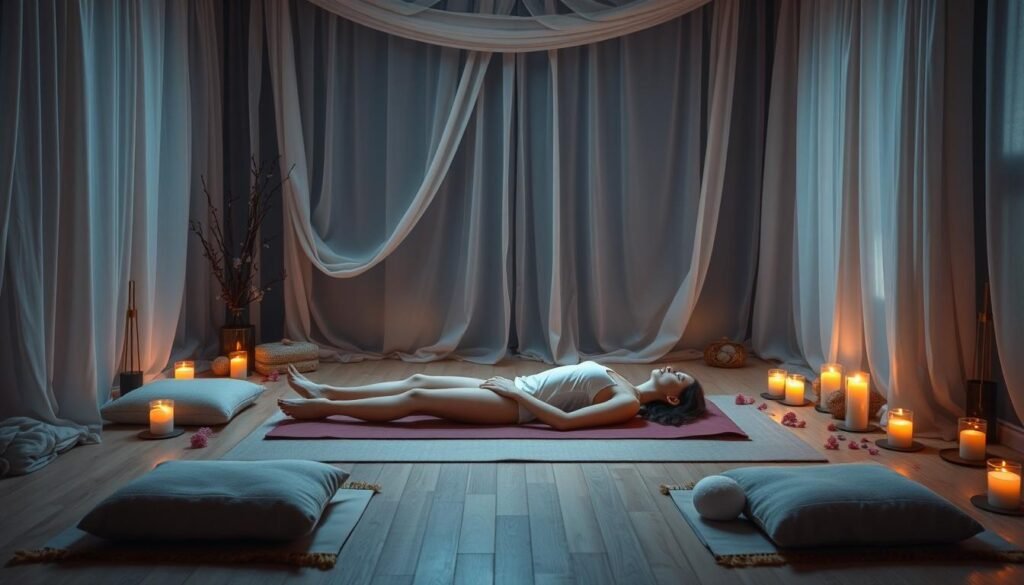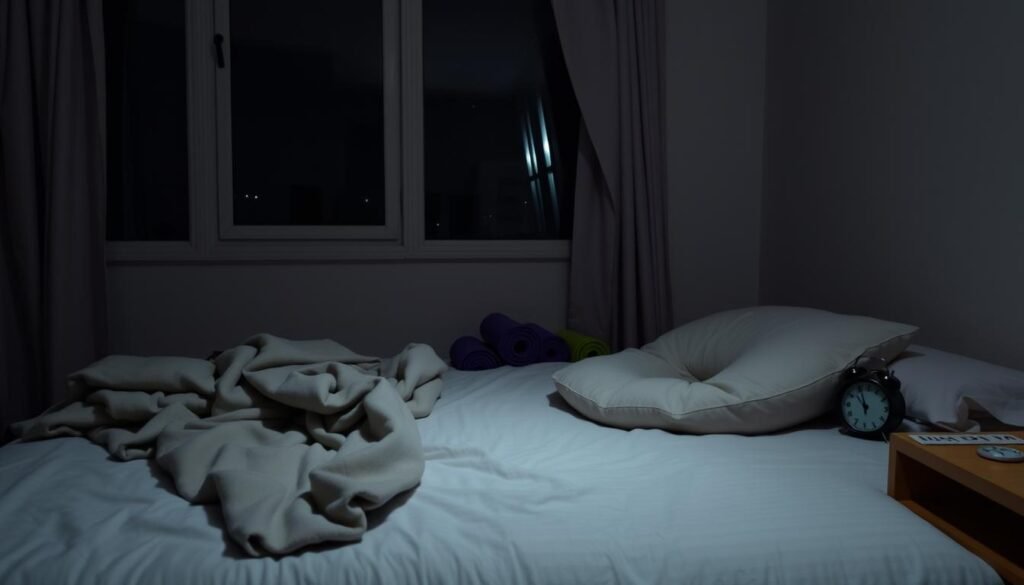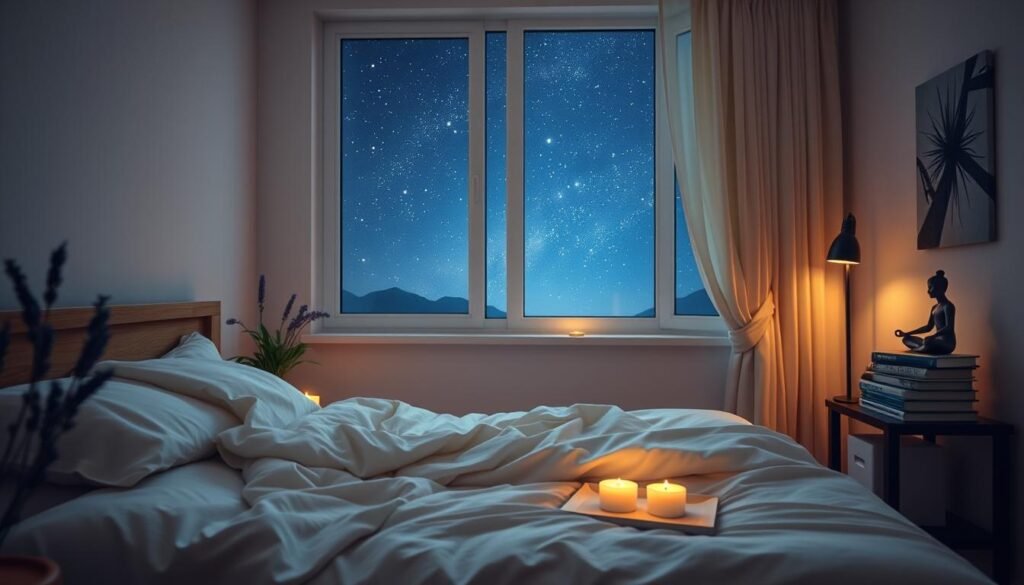Do you find yourself lying awake all night? You’re not alone. Almost one-third of American adults face sleep problems that make them tired and affect their daily life. Relaxation techniques can help you get better sleep and wake up feeling refreshed.
Not all sleep aids are medication. Meditation is a natural way to calm your mind and body for deep sleep. By learning and using these techniques, you can improve your sleep without drugs.
Today’s world is full of stressors that mess with our sleep. Work stress and too much screen time can lead to anxiety and trouble sleeping. But, there’s hope. Simple, proven relaxation methods can help you overcome these issues and get quality sleep again.
Key Takeaways
- Relaxation techniques can significantly improve sleep quality
- Stress directly impacts your ability to fall and stay asleep
- Natural methods can reduce anxiety and promote restfulness
- Consistent practice leads to long-term sleep improvements
- No expensive equipment or medications required
Understanding the Connection Between Relaxation and Sleep Quality
Sleep is a delicate process that your body’s stress response affects. When anxiety takes over, it’s hard to fall and stay asleep. Learning how relaxation techniques impact your sleep cycle can change your nighttime experience.
The Impact of Stress on Sleep
Stress triggers your body’s fight-or-flight response, releasing hormones like cortisol. These hormones keep you alert and anxious. Deep breathing exercises can help counteract these reactions, signaling your body to relax.
The Science of Relaxation Response
Your nervous system has two main modes: sympathetic (stress) and parasympathetic (relaxation). Progressive muscle relaxation activates the parasympathetic system. This system promotes healing, reduces tension, and prepares your body for quality sleep.
- Reduces cortisol levels
- Lowers heart rate
- Decreases muscle tension
- Promotes mental calmness
Benefits of Regular Relaxation Practice
Regular use of guided imagery and relaxation techniques can greatly improve your sleep quality. Studies show that those who practice these methods experience:
| Benefit | Impact |
|---|---|
| Reduced Anxiety | 33% decrease in sleep-related stress |
| Improved Sleep Duration | Extended sleep by 30-45 minutes |
| Enhanced Mental Clarity | Better morning cognitive function |
“Relaxation is not a luxury, but a critical component of healthy sleep.” – Sleep Research Institute
By understanding and implementing these techniques, you can transform your sleep experience and overall well-being.
Deep Breathing Exercises for Better Sleep
Breathing exercises are great natural sleep remedies. They can change your bedtime routine. Almost one-third of adults have trouble sleeping, making relaxation techniques very important. Deep breathing is a simple way to calm your mind and body for sleep.
Meditation for sleep gets easier with breathwork. Slow, deep breaths help your body relax. They help you move from stress to calm.
Diaphragmatic Breathing Method
This basic technique uses your diaphragm for relaxation. Here’s how to do it:
- Sit or lie in a comfy position
- Put one hand on your chest and the other on your stomach
- Breathe deeply through your nose, letting your stomach rise
- Do this for 5-10 minutes, 3-4 times a day
The 4-7-8 Breathing Technique
Dr. Andrew Weil made this breathing exercise popular:
- Inhale quietly through your nose for 4 seconds
- Hold your breath for 7 seconds
- Exhale completely through your mouth for 8 seconds
- Do this cycle four times
Proper Breathing Position for Maximum Benefits
Your breathing position affects how well these exercises work. Experts suggest:
| Position | Benefits |
|---|---|
| Lying Down | Promotes full diaphragm expansion |
| Seated Upright | Helps maintain focus and prevent falling asleep |
| Reclined Slightly | Balances comfort and alertness |
“Breathing is the first act of life and the last. Our very life depends on it.” – Elizabeth Brown
Consistency is key in breathing exercises. Practice every day for better sleep and relaxation.
Progressive Muscle Relaxation: A Full-Body Approach
Progressive muscle relaxation (PMR) is a powerful technique for better sleep. It was developed by Dr. Edmund Jacobson in the 1920s. This method helps you release tension in your body and mind.
“Relaxation is the prerequisite to any genuine change in consciousness.” – Dr. Edmund Jacobson
The basic idea of PMR is simple. When your muscles are relaxed, it’s hard to stay stressed. By tensing and then releasing muscle groups, you can improve your sleep and reduce anxiety.
How to Practice Progressive Muscle Relaxation
- Find a quiet, comfortable space
- Lie down or sit in a relaxed position
- Take slow, deep breaths
- Focus on one muscle group at a time
- Tense muscles for 5 seconds, then release
Research shows PMR can greatly improve sleep. A 2020 study of 80 burn patients found big drops in anxiety and better sleep after just 20-30 minutes of PMR each day.
Key Benefits of Progressive Muscle Relaxation
- Reduces muscle tension
- Decreases anxiety
- Improves sleep onset
- Lowers blood pressure
- Enhances overall relaxation
Pro tip: Experts say to practice PMR for 10-15 minutes before bed. It takes time to get good at it, so be patient.
Always talk to a healthcare professional before starting any new relaxation practice. This is important if you have muscle or injury issues.
Exploring Guided Imagery and Visualization Techniques
Guided imagery is a strong tool for changing how you sleep. It uses your mind to create calm scenes that help you relax and sleep better.
Visualization is a special way to relax. Studies show it can cut down stress and make sleep better. Even 30 minutes of guided imagery can be as good as a massage in easing stress.
Understanding Body Scan Meditation
Body scan meditation is a key technique for connecting with your body. It involves:
- Focusing on different body parts
- Releasing tension step by step
- Encouraging deep physical calm
Creating Peaceful Mental Scenarios
Making peaceful mental scenes takes practice. Sleep hypnosis and apps can help beginners. Here are tips for creating calm visuals:
- Imagine a calm place in your mind
- Use all your senses
- Focus on calming details
*”Visualization is daydreaming with a purpose”* – Bo Bennett
Guided Imagery Scripts for Sleep
Good guided imagery scripts can really help your sleep. Studies show daily practice can:
| Condition | Improvement Percentage |
|---|---|
| Anxiety | 65% |
| Stress | 60% |
| Sleep Quality | 55% |
Interestingly, about 95% of people can benefit from visualization. Only 5% might find it hard because of aphantasia. Begin your journey to better sleep with these powerful mental relaxation methods.
Relaxation techniques for sleep, Relaxation Techniques, Sleep Aids
Stress can make it hard to sleep well. In fact, 44 percent of adults have trouble sleeping because of stress. Luckily, there are many ways to relax and sleep better.
Adding relaxation techniques to your day can change your life. Studies show that gentle breathing and muscle relaxation for 20-25 minutes a day can lessen stress.
Key Sleep Enhancement Strategies:
- Calming music for sleep to create a peaceful environment
- Bedtime yoga for gentle body and mind relaxation
- Natural sleep supplements to support rest
Getting ready for bed starts during the day. Managing stress all day is key for a good night’s sleep. Natural sleep supplements can help, but they should be part of a bigger relaxation plan.
Relaxation Technique Effectiveness:
| Technique | Stress Reduction | Sleep Improvement |
|---|---|---|
| Deep Breathing | High | Significant |
| Bedtime Yoga | Moderate | Substantial |
| Calming Music | Moderate | Moderate |
“The quality of your sleep is a reflection of your daily stress management.” – Sleep Wellness Expert
Finding the right relaxation technique is up to you. Try calming music, bedtime yoga, or natural sleep supplements to see what works. Being consistent is important for a good relaxation routine.
Yoga Nidra and Non-Sleep Deep Rest Practices
Explore the world of yoga for sleep with Yoga Nidra and Non-Sleep Deep Rest (NSDR) practices. These meditation techniques offer a unique way to relax and refresh your mind.

Yoga Nidra, also known as “yogic sleep,” is a mindfulness meditation. It guides you into deep relaxation while keeping you awake. It has caught the eye of big names like Google CEO Sundar Pichai.
Understanding Yoga Nidra Practice
Yoga Nidra involves a step-by-step approach to relaxation:
- Lie comfortably on your back
- Follow guided mental imagery
- Maintain awareness during deep relaxation
- Focus on breath and body sensations
Benefits of NSDR for Sleep Quality
Research shows many benefits of these relaxation techniques:
| Benefit | Potential Impact |
|---|---|
| Stress Reduction | Lowers cortisol levels |
| Mental Health | Reduces anxiety and depression symptoms |
| Physiological Changes | Improves immune function |
“Yoga Nidra allows you to enter a state of conscious deep rest, bridging wakefulness and sleep.” – Yoga Research Experts
Clinical studies show that regular practice can greatly improve your well-being. These techniques are a great addition to your sleep routine.
Creating an Effective Bedtime Relaxation Routine
Creating a bedtime routine is key for better sleep. Studies show that a good evening routine tells your body it’s time to relax. Experts suggest spending 30 to 60 minutes before bed on relaxation.
“Your evening routine sets the stage for quality sleep and overall wellness.”
Start your evening with a “power-down” plan. Here’s a simple routine:
- First 20 minutes: Finish important tasks and get ready for tomorrow
- Next 20 minutes: Do some relaxing activities
- Final 20 minutes: Take care of yourself and calm down
Your bedtime routine could include calming activities:
- Light stretching or gentle yoga
- Writing in a journal to clear your mind
- Listening to pink noise or soft music
- Reading a calm book
- Doing deep breathing exercises
Also, make your bedroom sleep-friendly. Keep it cool, quiet, and dark. Choose soft, comfy bedding.
Finding the right bedtime routine takes time. Try different things and be patient. Find what works best for you.
Common Mistakes to Avoid When Using Relaxation Techniques
Getting good sleep is more than just wanting it. Many people find it hard to use natural sleep remedies because of common mistakes. These mistakes can make it tough to relax.

Relaxation techniques are great for better sleep, but they’re not easy. About 50% of people might need to try a few methods before finding what works best for them.
Timing Your Relaxation Practices
When you relax is just as important as how you relax. Here are some tips for timing:
- Avoid intense relaxation exercises right before bed
- Try relaxation techniques 30-60 minutes before sleep
- Find the best time for you to relax
Environmental Considerations for Optimal Relaxation
Your surroundings are key for relaxation. Think about these important factors:
| Environmental Factor | Recommended Setting |
|---|---|
| Room Temperature | 60°F to 67°F (15.6°C to 19.4°C) |
| Light Exposure | Keep away from blue light from screens |
| Noise Level | Choose white noise or a quiet place |
Be careful with screen brightness when using relaxation apps. Consistent practice is key. Relaxation techniques get better with more practice.
Remember, relaxation is a skill that improves with time and patience.
Stress hits about 77% of Americans often. So, it’s vital to find good ways to relax. By avoiding these mistakes, you can sleep better and feel better overall.
Conclusion
Your journey to better sleep through relaxation techniques is a powerful path to wellness. Almost one-third of people struggle with sleep. Natural sleep remedies can be a game-changer. The techniques we’ve discussed offer easy ways to lower stress and improve sleep quality.
Studies show that relaxation techniques can greatly improve your health. By using these methods, you might see your heart rate and blood pressure drop. Also, 40% of people say they feel less angry and frustrated after regular relaxation.
Keep in mind that everyone’s experience is different. While these sleep aids are usually safe, it’s important to talk to a doctor if you have health concerns. People with epilepsy or certain mental health issues should get medical advice before starting a new relaxation routine.
Your journey to better sleep is unique. Try different techniques, be patient, and stay consistent. The benefits go beyond sleep – you might see better focus, less stress, and overall well-being. Start using these natural strategies to change how you approach rest and relaxation.




